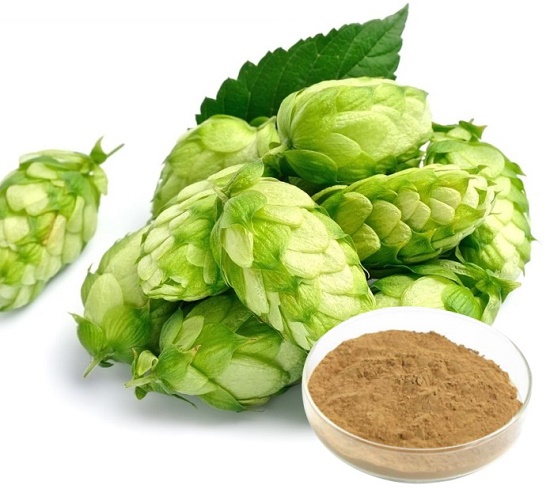Usage And Synthesis
Hops extract is obtained primarily from hop cones, sometimes from the lupulin glands on their surface. The extract abounds in essential oil ingredients: terpene and sesquiterpene compounds, such as humulene, myrcene, farnesene and caryophyllene. They are accompanied by bitter resins: alpha acids (lupulones), beta acids (humulones) and their derivatives (including methylbutenol) and many phenolic acids, tannins, flavonoids and chalcones. However, one of the most essential substances in hops extract is xanthohumol. It is a strong antioxidant and one of the compounds that determine beer flavour.


To date, the use of Hops extract in food has been investigated as an antioxidant that increases the stability of some essential components (proteins, fats) and some critical organoleptic elements (colour). The use of the antioxidant action of hops in preserving foods, thus prolonging their shelf life, has a lot of potential, especially for meat products, where it increases not only their freshness but also their functional properties.
Other foods in which hops extracts were added are bakery products. Along with the antifungal action, hops extract and adjacent lactic acid bacteria were used in leavens to produce bread. The consequence was increased the concentration of polyphenols in bread and its antioxidant activity.
The antioxidants in hops were also used to produce protective food films. Emulsion films based on different biopolymers were manufactured with the addition of alcoholic hop extract in various concentrations, resulting in films with a higher antioxidant capacity and, therefore, a higher degree of protection against food spoilage.
Hops extract can be added to various fruit juices. In the study by Mashkour et al., hops extract was added to cherry juice, which significantly increased the antioxidant capacity of the mixture and the sensory evaluation score[1].
Other foods in which hops extracts were added are bakery products. Along with the antifungal action, hops extract and adjacent lactic acid bacteria were used in leavens to produce bread. The consequence was increased the concentration of polyphenols in bread and its antioxidant activity.
The antioxidants in hops were also used to produce protective food films. Emulsion films based on different biopolymers were manufactured with the addition of alcoholic hop extract in various concentrations, resulting in films with a higher antioxidant capacity and, therefore, a higher degree of protection against food spoilage.
Hops extract can be added to various fruit juices. In the study by Mashkour et al., hops extract was added to cherry juice, which significantly increased the antioxidant capacity of the mixture and the sensory evaluation score[1].
Hops have been traditionally used as an herbal remedy for insomnia, anxiety and mood disorders, digestive issues and many other ailments. However, there is very little evidence to support any of these uses. The dried strobiles, extracts and tinctures are used medicinally, and hops are also available in many other forms, including beverages, tablets, capsules, creams, and gels. Studies suggest hops may have sedative, antioxidant, anti-inflammatory, antimicrobial, digestive, diuretic and estrogen-like properties. The pharmacological effects of hops are believed to be from the various bioactive compounds they contain, including lupulin, an aromatic acid, flavonoids such as xanthohumol, bitter resins, phenolic acids, volatile oils and tannins.
Preparation Products And Raw materials
Preparation Products
Related Product Information
PROMPT×
PROMPT
The What'sApp is temporarily not supported in mainland China
The What'sApp is temporarily not supported in mainland China
Cancel
Determine